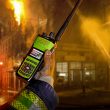NEARS seeks national directory funding
With a relatively small reallocation of funds, the nation can rapidly test interoperable emergency data messaging, using a combination of national emergency message and data standards, existing commercial software technologies and a centralized national electronic directory of agencies, according to a National Emergency Alerting and Response Systems initiative.
“September 11 showed us there’s more to this [first responder] world than just police, fire and medical,” said Richard Taylor, chair of the COMCARE alliance and a participant in the NEARS effort. “These are very important people, but there are also a lot of other folks who are first responders. … It’s no longer a small group. It’s associations, organizations, people and different groups we have to make contact with. We have to reach out, and we have to be able to share data.”
The Emergency Provider Access Directory (EPAD) is at the heart of the NEARS initiative. It is a geographically oriented directory built with standardized Web tools and would act as a secured, shared utility to ensure accurate routing and deployment of emergency messages to appropriate response agencies. Information profiles would be established and maintained by agencies themselves, choosing what information they receive, when and how they receive it, and who has access to the information. Ultimately, EPAD would include contact information for more than 80,000 public and private emergency agencies, more than 100,000 schools and more than 3000 media and private-sector organizations.
Messaging systems used by first-responder agencies would query EPAD to determine to whom and where messages should be sent. EPAD would return a list of agencies based on incident type and geographic region, so alert messages can be sent simultaneously to all requesting agencies.
One key feature of EPAD is that it is technology-agnostic. “There’s not a one-size-fits-all product [for first responders], and there probably won’t be,” said Jack Potter, director of emergency medical services for the Valley Health System in Southern Virginia. Potter said the federal government must focus on settling data standards and letting local municipalities buy the software tools they need and can afford or to adapt the software they already have in place. “A central toolset allows companies to develop applications or local jurisdictions can develop their own applications,” Potter said. “We can’t afford to replace what we already have in one fell swoop.”
Using Department of Justice funding, NEARS created a live prototype version of EPAD and demonstrated standardized interoperable data messaging between Maryland first-responder organizations at a June 16 press conference at the Russell Senate Office Building. Multiple commercial software vendors participated in the demonstration. “It is at the point where we can let people kick the tires,” Potter said. “But there’s a lot of work to be done yet.”
NEARS is supported by a broad range of organizations, including the American College of Emergency Physicians, COMCARE, Fraternal Order of Police, National Association of EMTs and National Volunteer Fire Council and the Public Broadcasting System. In addition, the effort has the bipartisan support of Sens. Conrad Burns (R-Mont.) and Hilary Rodham Clinton (D-N.Y.).
First responders that have seen the prototype in action are impressed.
“It takes interoperability to another level,” said Louis Cannon, president of the FOP in Washington and a police officer at the U.S. Mint. Cannon cited an incident at the last presidential inauguration where protesters had been pepper-sprayed. Area hospitals were notified of the incident through a NEARS software tool, saving both time and headaches. “They didn’t have to have people break out moon suits and think they came in contact with some weird chemical.”
NEARS says it would take two years and as much as $18 million dollars to move the demonstration version of EPAD and an emergency-messaging toolkit into a fully functional package. The price tag includes trials in five municipalities around the country. Funds are currently available across several organizations.

















